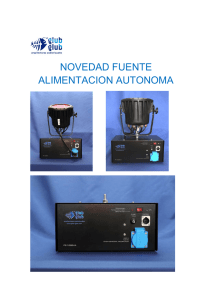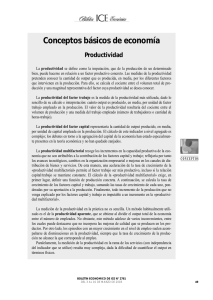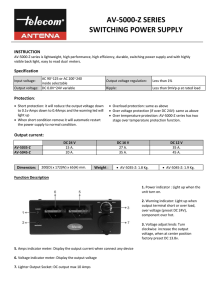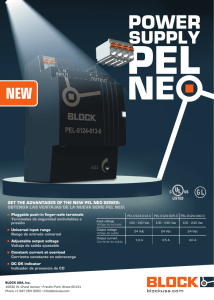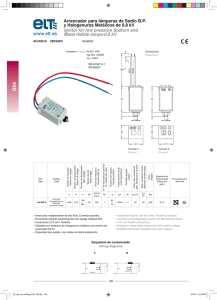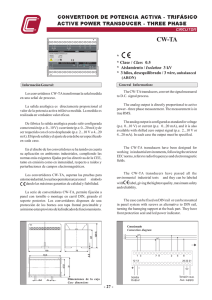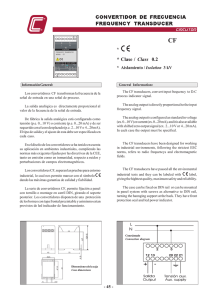Annex 3. Publicacions més representatives
Anuncio
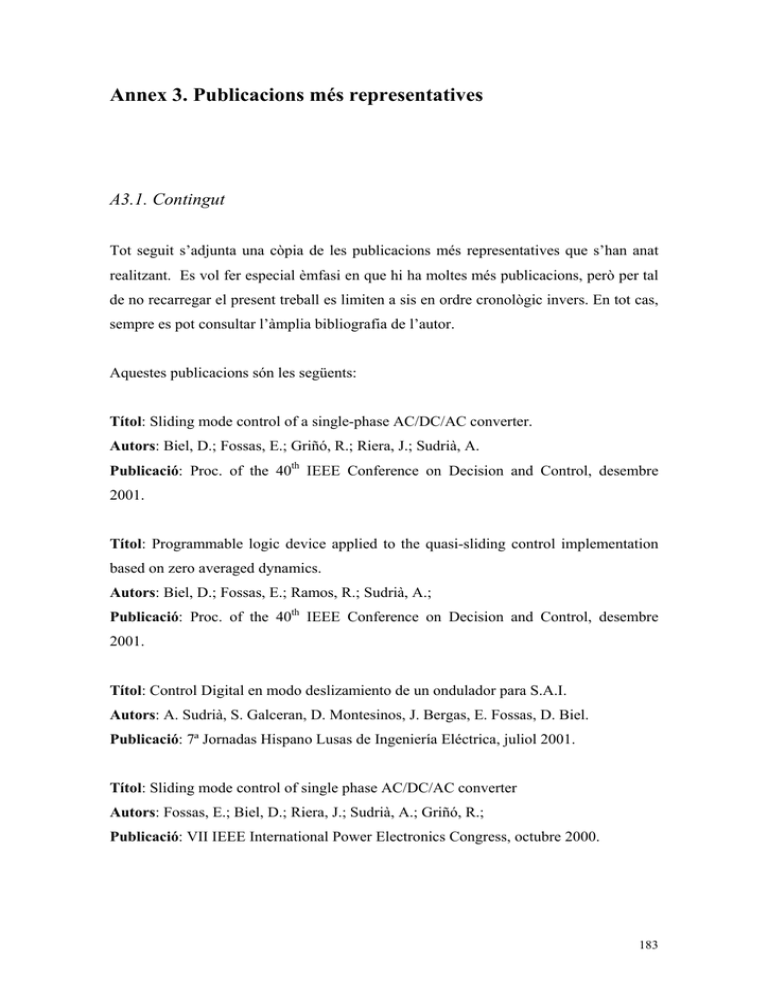
Annex 3. Publicacions més representatives
A3.1. Contingut
Tot seguit s’adjunta una còpia de les publicacions més representatives que s’han anat
realitzant. Es vol fer especial èmfasi en que hi ha moltes més publicacions, però per tal
de no recarregar el present treball es limiten a sis en ordre cronològic invers. En tot cas,
sempre es pot consultar l’àmplia bibliografia de l’autor.
Aquestes publicacions són les següents:
Títol: Sliding mode control of a single-phase AC/DC/AC converter.
Autors: Biel, D.; Fossas, E.; Griñó, R.; Riera, J.; Sudrià, A.
Publicació: Proc. of the 40th IEEE Conference on Decision and Control, desembre
2001.
Títol: Programmable logic device applied to the quasi-sliding control implementation
based on zero averaged dynamics.
Autors: Biel, D.; Fossas, E.; Ramos, R.; Sudrià, A.;
Publicació: Proc. of the 40th IEEE Conference on Decision and Control, desembre
2001.
Títol: Control Digital en modo deslizamiento de un ondulador para S.A.I.
Autors: A. Sudrià, S. Galceran, D. Montesinos, J. Bergas, E. Fossas, D. Biel.
Publicació: 7ª Jornadas Hispano Lusas de Ingeniería Eléctrica, juliol 2001.
Títol: Sliding mode control of single phase AC/DC/AC converter
Autors: Fossas, E.; Biel, D.; Riera, J.; Sudrià, A.; Griñó, R.;
Publicació: VII IEEE International Power Electronics Congress, octubre 2000.
183
Títol: Control de un SAI mediante un lazo interno de intensidad.
Autors: J. Bergas, A. Sudrià, S. Galceran, J. Rull.
Publicació: Seminario anual de automàtica, electrónica industrial e instrumentación,
Setembre 2000.
Títol: Sistemas de alimentación ininterrumpida.
Autor: Sudrià, A.
Publicació: Automàtica e Instrumentación, Maig 1987. ISSN: 0213-3113.
184
CONTROL DIGITAL EN MODO DESLIZAMIENTO DE
UN ONDULADOR PARA S.A.I.
Antoni Sudrià i Andreu(1), Samuel Galceran i Arellano(1), Daniel Montesinos i
Miracle(1), Joan Bergas i Jané(1), Enric Fossas Colet(2), Domingo Biel Solé(3)
(1)
Dept. Enginyeria
Elèctrica. ETSEIB.
Diagonal, 647. 08028
Barcelona.
[sudria],[galceran],[berg
as]@ee.upc.es
(2)
Institut d’Organització
i Control de Sistemes
Industrials. Diagonal,
647. 08028 Barcelona.
(3)
Dept. Enginyeria
Elèctrica. EUPVG.
Avgda. Víctor Balaguer,
s/n. 08800 Vilanova i la
Geltrú. biel@eel.upc.es
Resumen
En esta comunicación se presenta la implementación de un ondulador monofásico
con control deslizante. Después de una breve introducción de la teoría de control
deslizante, se propone una arquitectura del ondulador en semipuente, sin
transformador y con el neutro de la salida y el de la entrada conectados. Se
presentan los resultados de las simulaciones para distintas cargas y distintos
tiempos de cálculo del control digital. Finalmente, se presentan los resultados
obtenidos en un prototipo.
Introducción
En la actualidad las sociedades industriales avanzadas basan su desarrollo en las nuevas
Tecnologías de la Información y las Comunicaciones (TIC). Pero estas tecnologías son
muy sensibles a la calidad y continuidad de suministro de energía eléctrica. Por este
motivo los Sistemas de Alimentación Ininterrumpida (SAI) están alcanzando un nuevo
protagonismo como elementos fundamentales de la nueva sociedad de las TIC.
Los equipamientos de las TIC son en su mayoría equipos electrónicos que se comportan
como cargas no lineales para la red eléctrica que los alimenta. Las cargas no lineales
consumen corrientes no senoidales que el caso de ser alimentadas por SAI originan una
distorsión armónica de la onda senoidal de tensión. En estos momentos los SAI
presentes en el mercado presentan una Distorsión Armónica Total (THD) no inferior al
5%. El disminuir esta distorsión es el actual reto de diseño de los SAI.
La gran mayoría de fuentes de alimentación ininterrumpida existentes utilizan controles
diseñados mediante procedimientos lineales para generar una tensión senoidal a la
salida. Los métodos lineales de control presentan una fuerte dependencia frente a
perturbaciones de la carga y variación de los parámetros de la planta. Las formas de
onda obtenidas presentan una baja distorsión armónica cuando son sometidas a cargas
lineales, pero cuando la carga es no lineal, que es lo que pasa la mayoría de veces, la
distorsión armónica aumenta de forma considerable.
Para solucionar estos problemas, se presentan los métodos no lineales de control como
una buena alternativa y una solución factible con la electrónica disponible actualmente.
Entre los métodos no lineales, el control en modo deslizante (Sliding Mode), caso
particular de los sistemas de control de estructura variable, parece el más indicado para
controlar un sistema no lineal como es el ondulador monofásico.
Este método fue originalmente propuesto y elaborado por Emelianov y un grupo de
colaboradores, entre los cuales destaca Utkin e Itkin. No fue hasta principios de los
noventa que el mundo occidental le prestó una especial atención.
Método de control
Las principales prestaciones que se obtienen con este tipo de control son su robustez
frente variaciones de los parámetros de la planta y se pueden conseguir transitorios
rápidos y sin oscilaciones.
El nombre de modo deslizante se debe a que las trayectorias del sistema controlado
evolucionan hacia una superficie de deslizamiento y, en el supuesto de una frecuencia
de conmutación infinita, permanece sobre ella.
La superficie de conmutación viene dada por una función (s(x)=0) que depende de las
variables de estado, y en su caso,
del tiempo. En función del valor
de la ley de control se produce
una conmutación de un estado a
otro según la forma:
u=umáx si s(x)>0
u=umín si s(x)<0
Los problemas aparecen cuando la
frecuencia de conmutación no es
infinita. Los retardos de los
componentes electrónicos de
control, y el retardo del cálculo de
la función s(x), si se usa un
control digital, provocan un
fenómeno llamado chattering.
Éste es un rizado de alta
Fig. 1. Recta de deslizamiento y conmutación de la
frecuencia superpuesto a la onda
ley de control
fundamental. Para aproximarse al
caso ideal de frecuencia infinita, hace falta disminuir los retardos y el tiempo de cálculo,
pero siempre existirá la limitación en la frecuencia de conmutación de los interruptores
de potencia usados.
Las ecuaciones del sistema
son:
di
u = Ri t + L t + v c
dt
i t = il + ic
ic = C
dv c
dt
Considerando la tensión en el
Fig. 2. Esquema eléctrico del sistema
condensador y la derivada de
ésta como variables de estado,
la planta del sistema puede describirse de esta forma:
x& = Ax + Bu + Ed
y = Cx
v
x = c u ∈ {u máx ,u mín }
v&
c
1
0
A=
B=
−
R/L
−
1/LC
0
E = C = [1 0]
1
0
1/LC
En este sistema, la tensión en bornes del condensador tiene que seguir de la forma más
fidedigna posible la referencia, que en este caso es una senoide de amplitud y frecuencia
deseados. De esta forma se define el vector referencia:
v
xr = r
v& r
También se puede definir ahora el vector de estado de error como la diferencia entre el
vector referencia y el vector de
estado:
v − v c
xe = xr − x = r
v& r − v& c
El objeto del control es hacer nulo
este vector. Por eso se escoge la
superficie de conmutación como una
suma ponderada de las componentes
del vector de estado de error:
s(x e ) = k 1 (v r − v c ) + k 2 (v& r − v& c )
La ley de control u depende de la
conmutación previa de la forma:
u=umáx si s(x)>0
Fig. 3. Superfície de conmutación
u=umín si s(x)<0
La relación s(xe)=0 es la recta de
deslizamiento. Si la ley de control, supuesta de frecuencia infinita, hace que las
Fig. 4. Simulaciones en carga lineal a diferentes frecuencias de
cálculo. Se puede observar el chattering
trayectorias que caen sobre s(x)=0, evolucionan sobre ella, se dice que el sistema se
comporta en modo deslizante. En la práctica, la frecuencia de conmutación es finita y a
lo sumo cabe esperar que las trayectorias que pasan por la curva s(x,t)=0 evolucionen en
un pequeño entorno tubular de la misma.
Simulaciones
En los resultados de las simulaciones (figura 4) se puede ver la gran influencia de la
frecuencia de cálculo sobre la onda de salida y el chattering. A 20 kHz de cálculo (eso
es, se calcula la función s a una frecuéncia de 20 kHz) la onda de salida es inaceptable,
pero a 60 kHz, el chattering se reduce de forma drástica. A esta frecuencia, la distorsión
armónica es muy pequeña.
Las simulaciones con carga no lineal (figura 5) predicen unos resultados aceptables. A
duras penas se aprecia la típica deformación de los controles lineales.
Implementación física
Se presenta aquí una arquitectura de ondulador en semipuente de IGBTs (figura 6). Un
filtro pasivo LC filtra la onda de salida. La estructura en semipuente presenta una serie
de características que la hacen muy atractiva. Al presentar un número menor de
interruptores de potencia se reduce la electrónica para controlar estos interruptores.
Permite, también, la posibilidad de construir un ondulador sin transformador, donde el
neutro de la salida es el mismo que el de la entrada. Sin embargo, su principal
inconveniente reside en la necesidad de trabajar a tensiones más elevadas en el bus de
continua para obtener la misma salida que en un ondulador de puente completo.
Para implementar el control se ha usado un DSP (Digital Signal Processor).
Fig. 5. Simulación en carga no lineal a 60
kHz de cálculo
Concretamente el TMS320F243 de Texas Instruments. Éste incorpora todos los
periféricos necesarios par el control de convertidores conmutados de potencia, como
pueden conversores analógico-digitales, registros PWM con inclusión de tiempo muerto
entre interruptores de una misma rama, un puerto serie de comunicaciones con otros
periféricos, y otros muchos que en esta aplicación no se han usado (Capturadores para
encoders, bus serie de comunicaciones, controlador de bus CAN).
Fig. 6. Arquitectura del convertidor
El prototipo construido obtiene la tensión del bus de continua a través de un rectificador
de diodos trifásico. El neutro del sistema trifásico, de 400 V, está conectado con el
punto medio de los condensadores del bus de continua. De esta forma se obtiene un a
tensión en este bus de unos 560 V. Para el bus de continua se ha escogido una batería de
seis condensadores electrolíticos de 1.5 mF cada uno, repartidos de tres en tres para
generar las dos mitades. Los interruptores de potencia usados son BSM25GB120 de
Siemens. El filtro LC de salida tiene las siguientes características: una bobina de 2.5
mH y un condensador de 52.2 µF, con una frecuencia de corte de 440 Hz
La senoide de referencia, generada internamente en el DSP, se ha fijado a un valor de
160 V eficaces y 50 Hz. El prototipo se ha hecho trabajar hasta cargas de 1 kW, tanto en
régimen lineal como no lineal. El error de tensión en ambos casos es de 1 V, i la
distorsión armónica, en caso lineal es de 1.5 %, y en caso no lineal del 1.8 %.
Los resultados obtenidos en el prototipo son igualmente satisfactorios, y auguran un
buen futuro para este método de control. Si bien la distorsión armónica es menor de
1.9% en ambos casos, el problema del chattering persiste.
1>
2>
1) 64kHz lineal:
62 Volt 5 ms
2) 64kHz no lineal:
Fig. 7. Resultados en carga lineal y no lineal
62 Volt 5 ms
Conclusiones
El presente articulo propone una nueva metodología de control no lineal conocida como
modo deslizamiento. La principal aportación del control modo deslizamiento es su
robustez frente a perturbaciones, por tanto parece una tecnología de control
perfectamente adaptada para responder a las cargas no lineales de las TIC. La principal
dificultad de la aplicación práctica del control modo deslizamiento es la necesidad de
efectuar los cálculos necesarios con una elevada velocidad para conseguir frecuencias
de ejecución del algoritmo de control no inferiores a 40 kHz.
También se ha construido un prototipo de ondulador para SAI controlado con modo
deslizante mediante un Procesador Digital de Señal (DSP) con una frecuencia de
ejecución de 64 kHz consiguiendo una Distorsión Armónica Total (THD) inferior al
1,9% alimentando cargas totalmente no lineales.
Se ha podido ver aquí como el control en modo deslizamiento se presenta como una
buena solución para el control de sistemas no lineales. Si bien los resultados en
simulación son muy buenos, destacando los obtenidos en carga no lineal, los resultados
obtenidos mediante la construcción de un prototipo, no son tan buenos, pero presentan
la particularidad de robustez frente a variaciones de los parámetros y buen resultado
frente a cargas no lineales. Cabe solucionar en un futuro el problema del chattering
Referencias
[1] D. Biel: Control en modo deslizante aplicado a la generación de señal en convertidores
conmutados DC/DC, Tesis Doctoral, UPC, 1999
[2] M. Carpita: Sliding mode controlled inverter with switching optimization techniques,
European Power Electronics Journal, V. 4, Nº 3, pp. 30-35, 1994
[3] Utkin, Guldner, Shi: Sliding mode control in electromechanical systems, Taylor & Francis,
1999
CIEP
Sliding Mode Control of Single PhaseAC/DC/AC Converter
-)lip+
ri
Enric Fossas', Domingo Biel", Jordi Riera',
Antoni Sudniw and Robert Grifi6'
2000
Acapulco, MEXICO
October 15 - 19
+ Institut d'Organitzaci6 i control de Sistemes Industrials. IOC. AV.Diagonal, 647, planta 11. ETSEIB. UPC. 08028Barcelona. Spain. Phone. 34-3-4017779, Fax. 34-3-4016605, e-mail: fossas@ioc.upc.es
++ Dpt. d'Enginyeria Electr6nica. E.U.P.V.G. UPC. C/ Victor Balaguer s/n. 08800- Vilanova i la Geltni (Barcelona).
Spain. Phone: 34-3-8967780, Fax: 34-3-8967700, e-mail: biel@eel.upc.es
v Instituto de Rob6tica Industrial. IRI.UPC. Campus Nord. Nexus. C/Jordi Girona, 1-3.Barcelona. Spain.
vv Dpt. d'Enginyeria Elktrica. AV.Diagonal, 647, planta 11. ETSEIB. UPC. 08028-Barcelona. Spain.
Abstract- This work is devoted to the design of a sliding mode
control scheme for a single phase aclddac converter in output
AC signal tracking task, maintaining unity power factor. The
control scheme is found to be robust with respect to parameters
variations and external disturbances. The analysis of the sliding
domain provides us with a converter parameters design
procedure; which, in turn, can be used to minimize the de link
capacitors.
proposed and their robustness analyzed. Simulation results
are also presented. Finally, the last section summarizes the
conclusion.
11. SINGLE PHASE INVERTER WITH INPUT RECTIFIER STATE
EQUATION
I. INTRODUCTION
The most popular acldclac power conversion is done by
means of a P W M rectifier-inverter system with dc voltage
link. This approach makes use of a capacitor (normally
electrolytic, bulky and expensive) in the dc link, which
causes decoupling between the rectifier and the inverter.
Some of the last studies in acldclac power conversion deals
with the strategies to reduce the dc-link capacitors [8]-[lo].
The desired unity power factor constitutes the main rectifier
requirement as long as the AC output voltage has to be in
phase with the AC input voltage and with a reduced THD
factor. The control technique mostly used to drive the two
decoupling converters is based on the usual and well known
linearization technique applied to the design of PWM control
schemes, Sliding-mode control techniques have been
proposed as an alternative to PWM control strategies in DCDC switching regulators since they make these systems very
robust to perturbations, namely variations of the input
voltage and/or in the load [3]-[5]. These techniques have also
been applied to the design of high-efficiency inverters, where
a switching DC-DC converter is forced to track, by means of
an appropriate sliding-mode control action, an external
sinusoidal reference [2],[6],[7].
The work here reported proposes two switching surfaces
and their respective control policies for the output voltage
tracking and to guarantee unity power factor in a single phase
inverter with input rectifier. The paper is organized as
follows: in the section 2 the ac/dc/ac power system is
described and their normalized state equations are presented;
then the switching surfaces are proposed in section 3; the
sliding domains are deduced and the design restrictions are
detailed in section 4; subsequently a switching control law is
0-7803-6489-9/00/$10.000 2000 IEEE
Consider the single phase inverter with phase controlled
rectifier acting as power supply, depicted in Figure 1, where
half bridges have been employed to ensure the bipolarity of
the AC output.
I
I
I
Y
Fig. 1. Single phase inverter with rectifier
'
diL1
L1.= (vg- VCl) + U 2 .(VCl +vc2)
dz
CI
-e
dvcl
+
= ( ~ LI i ~ 2 ) ut . i ~ 2 u2 . ~ L I
dz'
di~2
' L2.-=
(vcl-vo)-ul.(vcl+vc2)
dz
dvc2
C2.=u 1 . i~ U~ ~ . ~ L I
dz
dvo
c3
-= iL2 - iload
(1)
dz
where, as it can be seen in Figure 1, iL1 and i ~ are
2 currents
through the inductors, iload is the current through the load,
VCI, vc2 and vo are voltages between the terminals of the
capacitors, LI and L2 are inductance's values, CI,C2 and C3
are capacitance's values, Vg is the input voltage, and u1,u2
are the control signals, which belong to the discrete set { O,l] .
27 1
k
For a systematic study it is convenient to consider a
dimensionless model obtained by the change of variables
1
XI
= -. (VCl + vc2)
b
I
x2 = - .(VCl - vc2)
b
1
X 3 = -.VO
b
Vl
v2 = 1-2u2
= I - 2241
Remark that the relative degrees of SI and S2 are 1 and 2
respectively. Thus, the suitable sliding slrfaces will be
0 1 = y1- k(n).h(t)
(5)
d
07 = ( X 3 - h ) + kl . - ( X 3 - h )
(6)
dt
where k(n) have to be dynamically defined in such a way that
the stored energy remain in a band established beforehand.
It is straightforward to prove:
d dgI2 -0; --=o
d dm2
a1 d t
a 2 dt
so, a/will tend to zero under an appropriate design of v2
independently of the value of V I ; respectively for 02, v / and
vz .
The control laws
+1
-1
+1
-1
dr2
-=
~
if
if
if
if
m<O
m>O
CTI
01
(7)
>O
<0
make 01’ and 0-2’ be Lyapunov functions; therefore 01 and
02 tend to zero and the desired behaviour is ensured. As in
[6], the performance of equation (6) guaranties a robust
dynamics with respect to load disturbances.
With regard to the value of k(n), notice that, from equation
(4) the system is conservative if and only if
Y l -Y2
dt
dr3
-= c .(y2 - yload)
dt
k ( n ) . h 2 ( t )= yload.h(t)
(9)
In order to consider implementation in a digital processor,
equation (9) has to be solved in every output signal cycle
considering that k(n) maintains its value during the cycle.
This work proposes the following approximation of
equation (9)
yIoad. h( t )
k ( n ) . h 2 ( t )= y I o a d . h ( t ) 3 k(n) =
(10)
Also notice that the energy stored in the plant can be
measured bv
E = -.xI2 + -1. ~ 2 ~+ y I 2 +-.yz2
1
+-.xl?]
1
(3)
2
L
C
and that
i:
~
(4)
h2(t)
that guaranties energy conservative balance equation in
average values.
It has to be noted that
2
Ilo .
2
1
h ( t ) = j o [sin(2~&)] d t =26.)
describes the energy balance
111. DESIGN
AND ANALYSIS
0
The requirements the acldclac converter have to meet are:
the input current ought to be in phase with the input
voltage (unity power factor),
the output voltage provided to the load must be a sinus
wave of 50 Hz of frequency and b=220 V of amplitude.
This demands can also be written as
s1= yl(t)-k(n).h(t) = o
~2 3 x3(t)-sin(2zat) = o
where
[:
t E -’-
h ( t ) =sin(2zat)and
k(n)
is
constant
for
all
yload .h(t) =
Finally, the value of k(n) has to be known at the beginning
of the output AC voltage cycle as a function of the
instantaneous and previous states of the input and output
energy. In this work the following recursive equation has
been chosen
k ( n ) = k( n - 1) - a .( E l ( n - 1) - &2(n - 1))
( 11)
where
n:l]*
Lets go to design a controller, based on sliding mode
theory, in such a way that the previous tracking condition be
satisfied.
loI l o y l o a d . s i n ( 2 z a t ) d t
E I ( ~ =) y l . h ( t )
, that is ~ l ( n=) k ( n ) . h 2 ( t ) in steady
state sliding motion and a ( n )= yload . h ( t ) .
It can be easily proved that the recursive equation goes to
k(n) with an appropriate value of the cz parameter.
272
Thus taken into account the energy balance:
Instantaneous state: AE(n) = E I ( ~-) n ( n )
Previous state: AE(n - 1) = ~ l ( n 1) - n ( n - 1)
the recursive equation converges when:
In the physical parameter values the above equations read
2
b - l j ( l + g ) 2 + ( 4 z . SR . f )
b.
replacing the energy expressions
-
/[ g)
(2 +
- 8 2 L2C3.j-2
I'
I(vcl+v
L2
+ (4,..-.j-)
R
)
I(VCl + vc2)
which, in turn, can be written as
k ( n - 1) 2 ( t ) - n ( n )
E I (~ 1) - fl(n - 1)
and, finally, as the output energy does not change:
n ( n ) = n ( n - 1)
leading to the design inequation of the a parameter.
where
I.+)=
1
(
2 . 2 . s + 2+-c3)
R
Iv. SLIDING DOMAIN AND CONVERTER PARAMETERS DESIGN
PROCEDURE
The equivalent control VIeq (respectively vdeq) describing
the dynamical behavior of the converter on the sliding
surface, can be obtained from equation ( 2 ) , and in steady
state is given by
respectively
When the inverter's load is resistive the equivalent control
become
.A([)]
(14)
Finally, the sliding domain is defined by
of course the target trajectories ought to lie in the sliding
domain, this leading to
I(2.a'
+ ( 2 y . 2 T 42
<XI
273
The defined analog filters pl(s) and p ( s ) can be taken
into account in the converter parameters design procedure.
The frequency response of the filter can be drawn and can
be used to know the parameters range for which the sliding
domain is ensured. For instance, this methodology allows to
obtain the minimal value of the capacitors CZ and C2 as a
function of the AC input 'and output voltage amplitude and
the load value.
v. SIMULATION RESULTS
The previous control law has been simulated in a single
phase inverter with input rectifier with the following
parameters: L1=2mH, L2=l SmH, C1=C2=100pF, C3=80pF
and an output frequency of 50Hz. The control parameters are
k1=0.5 and ~ 2 0 Simulations
.
show the behaviour of the
state variables after a transient until the dc llnk capacitors be
charged. Namely, the initial conditions are: x1(0)=3.5,
x2(0)=0, y1(0)=0, x3(0)=0 and y2(0)=0.
The designed system has been simulated for a pulsating
resistive load. Figures 3 and 4 show the output voltage error
(defined as the difference between the reference and the
output voltage) and the input current, the output current and
the output voltage, respectively. The corresponding
dynamical behaviour of the output rectifier voltage is shown
in Figure 2 .
In order to consider a more realistic situation the switching
frequency has been limited to 15 lcHz by means of a analog
hysteresis comparator. The Figures 5 and 6 show the
corresponding output voltage error and the input current, the
output current and the output voltage when the power system
has a nonlinear load.
As it can seen these results validate the proposed design.
VI. CONCLUSION
In this paper, a robust sliding-mode control scheme for a
single phase acfdcfac tracking system with unity power factor
has been proposed. The design procedure presented in this
work, suggests two sliding surfaces and the corresponding
switching control laws leading to the mentioned objectives. A
converter parameters design procedure that can be used to
minimize the dc link capacitor, has been also proposed. The
theoretical predictions have been validated by means of
simulations results.
w
o
m
w
m
.
I
.""
?m
1w
*m
1-
(D
Fig. 4. Input current, the output current and the output voltage when the
inverter has a pulsating resistive load.
I
Fig. 2. Dynamical behaviour of the output rectifier voltage.
0 1
,
'
am
o
1
a
a
I
m
w
i
m
w
m
m
-a
.-
Fig. 5. Output voltage error when the inverter
has a pulsating resistive load with limited frequency.
*m
o
n
o
o
m
-m.
m
ta
o
IO
Fig. 3. Output voltage error when the inverter
'
has a pulsating resistive load.
I
I
0
m
a
m
a
-4
Im
qw
14
lm
tm
h.
Fig. 6. Input current, the output current and the output voltage when the
inverter has a pulsating resistive load with limited frequency.
274
ACKNOWLEDGMENT
This work has been partially sponsored by the ~
Interministerial de Ciencia y Tecnologia ‘IcyT
~
0969-C03-03,Ol.
REFERENCES
[4] Utkin, V.I. “Sliding mode and their applications in variable structure
systems”. Mir. Moscow, 1978.
[ 5 ] Venkataramanan
R, Sabanovic
~
~
i
bA. and Cuk
~ S. “Sliding mode control of
DC-to-DC converters”. Proceedings IECON 1985. pp. 251-258.
[6] Carpita M, Marchesioni M, Oberti M. and Puguisi L. “Power
conditioning system using sliding mode control”. Proceedings PESC
1988. pp. 623-633.
[7] Biel D, Fossas E., Guinjoan F and Ramos R. “Sliding Mode Control of a
Boost-Buck Converter for AC simal tracking task”. Proceedings of
ISCAS’99. Orlando 1999. pp. 242->45.
[8] Malesani L. M., Rossetto L. and Tomasin P. “AC/DC/AC PWM
converter with reduced energy stored in the DC link”. IEEE Trans. Ind.
Applicat. V. 31. Mar./Apr. 1995. pp. 287-292.
[9] Kim J. S. and Sui S. K. “New control scheme for acdc-ac converter
without dc link electrolytic capacitor”. Proceedings PESC 1993. pp.
300-306.
[IO] Jung J., Lim S . and Nam K. “A Feedback Linearizing control scheme
for a PWM Converter-Inverter having very small DC-link capacitor”.
IEEE Trans. Ind. Applicat. V. 35. Sep../Oct. 1999. pp. 1124-1 131.
-
Biel D, Fossas E. and Guinjoan F. “Application of Sliding Mode
Control to the design of e Buck-based Sinusoidal Generator”.
Proceedingsof ISIE’99. Bled 1999.
Fossas, E and Biel, D. “A Sliding mode approach to robust generation
on dc-todc Converters”. Conf. on Dec. and Control. Kobe, Japan. 1996.
pp. 40104012.
Sira-Ramirez, H. “Sliding motions in bilinear switched networks”. IEEE
Trans. on Circuits and Systems. V. cas 34 N. 8 August 1987. pp. 919933.
275
1
